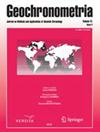二氧化碳升高期间,波兰工业化程度最高地区的树木年轮宽度和松树年轮的稳定同位素组成作为气候指标
IF 0.9
4区 地球科学
Q3 Earth and Planetary Sciences
引用次数: 7
摘要
摘要对波兰3个工业区16个样地生长的苏格兰松(Pinus sylvestris L.)进行了分析,以划分树木气候均匀区。树木年代学和质谱分析表明:9月前干燥晴朗、冬季低温和7月的水分供应限制了所有地区松树的径向生长。当前生长季节的气候条件在同位素比值中反映最为强烈。δ13C与温度、日照呈显著正相关。δ13C与降水、δ13C与湿度呈负相关。同时,δ18O与日照、δ18O与温度呈正相关,与湿度呈负相关。稳定同位素组成记录的气候信号具有时间不稳定性,只有少数气候参数具有时间稳定的气候信号。然而,已经观察到变量之间关系的强度和方向的可变性。总的来说,7月和8月的天气对确定δ13C和δ18O信号很重要。不稳定性可以反映植物对生态系统变化的生理适应。本文章由计算机程序翻译,如有差异,请以英文原文为准。
Tree-ring widths and the stable isotope composition of pine tree-rings as climate indicators in the most industrialised part of Poland during CO2 elevation
Abstract Scots pine (Pinus sylvestris L.) growing in 16 sites in three industrial regions in Poland was analysed to delineate dendroclimatologically uniform areas. A dendrochronological and mass spectrometric analysis revealed the following: a dry and sunny previous September, low winter temperature, and moisture supply in July limit the radial growth of the pines in all the regions. The weather conditions of the current growing season have been the most strongly reflected in the isotopic ratio. Positive relationships were noted between δ13C and temperature and δ13C and sunshine. A negative relationship was observed between δ13C and precipitation and δ13C and humidity. At the same time, a positive relationship was noted between δ18O and sunshine and δ18O and temperature, but negative between δ18O and humidity. The climate signal recorded in the stable isotope composition was temporally unstable and only for a few of the climatic parameters did we find temporally stable climate signals. However, variability in the strength and direction of the relationships between variables has been observed. In general, the weather in July and August is important for determining the δ13C and δ18O signals. Instability can reflect the physiological adaptation of the plants to changes in the ecosystem.
求助全文
通过发布文献求助,成功后即可免费获取论文全文。
去求助
来源期刊

Geochronometria
地学-地球科学综合
CiteScore
2.20
自引率
0.00%
发文量
1
审稿时长
>12 weeks
期刊介绍:
Geochronometria is aimed at integrating scientists developing different methods of absolute chronology and using them in different fields of earth and other natural sciences and archaeology. The methods in use are e.g. radiocarbon, stable isotopes, isotopes of natural decay series, optically stimulated luminescence, thermoluminescence, EPR/ESR, dendrochronology, varve chronology. The journal publishes papers that are devoted to developing the dating methods as well as studies concentrating on their applications in geology, palaeoclimatology, palaeobiology, palaeohydrology, geocgraphy and archaeology etc.
 求助内容:
求助内容: 应助结果提醒方式:
应助结果提醒方式:


